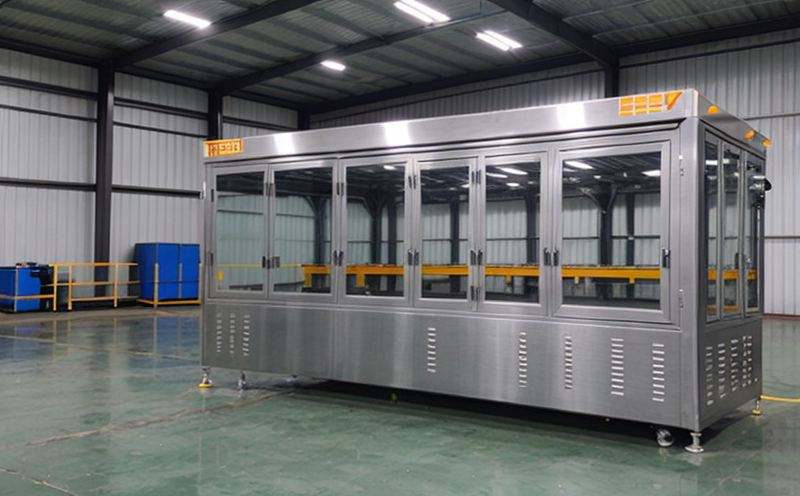ISO 7438 Bend Test for Metal Packaging
The ISO 7438 Bend Test is a critical procedure used to evaluate the mechanical properties of metal packaging materials. This test assesses the flexibility and structural integrity of metal packaging by measuring how well it can withstand bending without compromising its strength or seal integrity.
This test is essential in ensuring that metal packaging meets regulatory requirements and performs optimally under various environmental conditions. The procedure involves placing a sample of the metal packaging between two rollers, applying a specified bending force, and then examining the degree to which the material deforms.
The ISO 7438 standard provides specific guidelines for specimen preparation, test setup, and measurement procedures. It ensures that all samples are tested under controlled conditions, allowing for consistent and accurate results. This consistency is crucial in maintaining quality standards across different manufacturing processes and suppliers.
In practice, this test helps manufacturers identify potential weaknesses in their packaging design, ensuring that the final product can withstand the rigors of transportation and storage without compromising its integrity. By conducting regular ISO 7438 tests, companies can improve product reliability, reduce defects, and enhance customer satisfaction.
The bend test also plays a vital role in quality control processes by providing objective data on packaging performance. This data is invaluable for R&D teams looking to innovate new materials or design improvements. By understanding how different factors like material thickness, surface finish, or alloy composition affect bending behavior, engineers can optimize their designs for better performance.
The test’s application extends beyond just identifying defects; it also serves as a benchmark for comparing different packaging solutions. For example, when selecting between two competing materials, the ISO 7438 bend test results can provide clear insights into which option offers superior flexibility and durability.
Moreover, compliance with this standard is increasingly becoming mandatory in many industries due to stringent regulations aimed at ensuring product safety and environmental sustainability. Companies that fail to meet these standards risk facing penalties or recalls, making the ISO 7438 bend test an indispensable tool for maintaining regulatory compliance.
The procedure itself involves several key steps: selecting appropriate specimens based on intended use; preparing them according to standard specifications; positioning them between rollers at specific angles and distances; applying a precise bending force; measuring the resulting bend angle or deflection; and finally, evaluating whether the sample meets predefined criteria. Each step requires careful attention to detail to ensure accurate results.
- What is the purpose of the ISO 7438 Bend Test? The primary goal is to assess the flexibility and structural integrity of metal packaging materials under bending loads.
- Who benefits from this test? Quality managers, compliance officers, R&D engineers, and procurement specialists benefit significantly by ensuring product reliability and regulatory compliance.
- What materials are suitable for ISO 7438 testing? Most metal packaging materials can be tested using this method, including aluminum foils, cans, trays, and lids.
- How often should the test be conducted? Regularly during development phases and periodically in production to monitor quality consistency.
- Can this test detect all defects? While effective, no single test can identify every possible flaw; it complements other testing methods for comprehensive evaluation.
- Is there a difference between manual and automated systems? Automated systems offer greater precision but require initial calibration and maintenance. Manual tests are simpler but less precise.
- How does this test contribute to sustainability? By improving packaging performance, it reduces waste by enhancing recyclability and longevity of products.
- What role do international standards play in metal packaging design? Standards like ISO 7438 provide universal benchmarks that ensure compatibility across global markets.
Applied Standards
The ISO 7438 Bend Test is part of a broader suite of standards designed to enhance the quality and safety of metal packaging. These include ISO 15096, which specifies requirements for food contact materials and articles; EN 10112-1, dealing with tinplate; and ASTM D1777, covering tin containers.
The alignment of these standards ensures that manufacturers adhere to internationally recognized best practices. Compliance not only protects consumer health but also fosters trust among end users who rely on safe and reliable packaging solutions.
Industry Applications
The ISO 7438 Bend Test finds extensive application across various sectors where metal packaging plays a crucial role. Key areas include food, beverage, pharmaceuticals, cosmetics, electronics, and automotive components.
In the food industry, ensuring that cans or trays can withstand transportation without compromising contents is paramount. This test helps prevent leaks and maintains product freshness throughout distribution channels.
The same principles apply to beverages where maintaining airtight seals ensures flavor preservation and prevents contamination during handling.
Pharmaceutical companies use this test to verify that drug containers protect medications from external influences, ensuring efficacy and safety.
Cosmetics benefit similarly by preventing leakage or damage during transport, thus preserving product quality.





